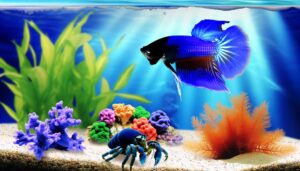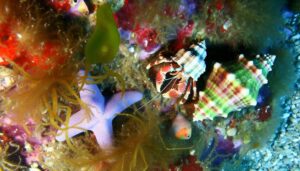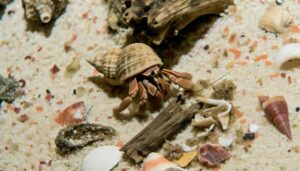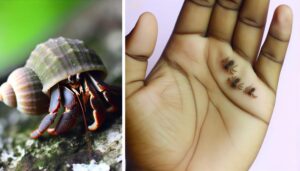Do Hermit Crabs Have Brains?
Hermit crabs don't have blood like humans. Instead, they use hemolymph, a circulatory fluid found in many arthropods.
Their open circulatory system means hemolymph directly bathes internal organs within the hemocoel. The heart pumps hemolymph through arteries, distributing nutrients, oxygen, and removing waste.
Hemolymph contains hemocyanin, a copper-based protein, which efficiently transports oxygen even in low-oxygen environments. This fluid also plays a pivotal role in immune responses and buoyancy regulation.
You'll find hermit crabs are highly adapted for various habitats, with specialized physiology that allows them to thrive. Discovering these fascinating mechanisms reveals much about their survival strategies.
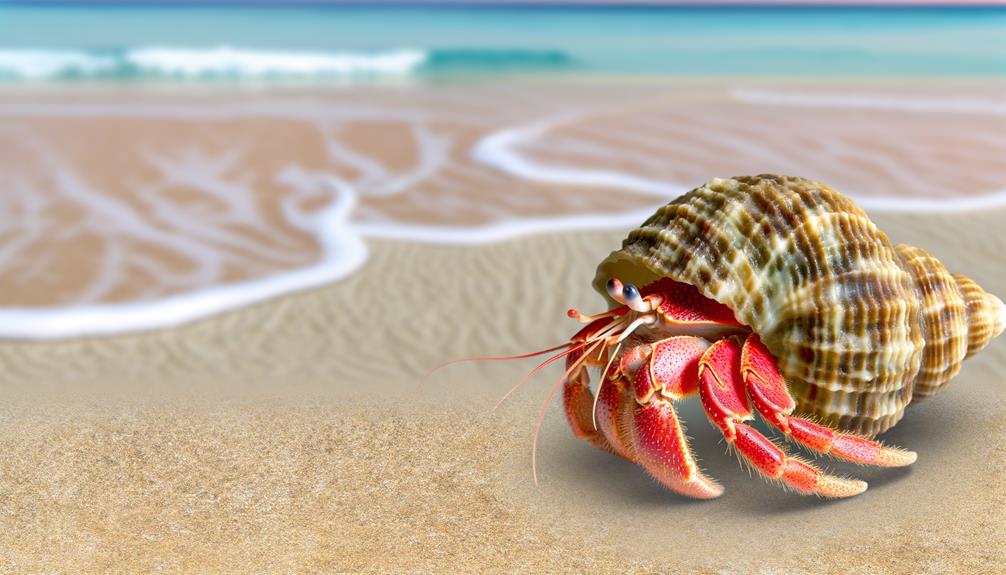
Key Takeaways
- Hermit crabs do not have blood; they have hemolymph.
- Hemolymph functions similarly to blood, transporting nutrients, oxygen, and waste.
- Hemolymph contains hemocyanin, a copper-based oxygen carrier.
- The open circulatory system allows hemolymph to bathe organs directly.
- Hemolymph plays a crucial role in the immune response and buoyancy regulation.
Anatomy of Hermit Crabs
The anatomy of hermit crabs, comprising a soft, asymmetrical abdomen and a rigid exoskeleton, is carefully adapted for their unique lifestyle of inhabiting discarded shells.
You'll notice that their exoskeleton offers protection while their abdomen, lacking such armor, fits snugly into various shells they find. This adaptation guarantees survival, providing both mobility and defense.
Additionally, the asymmetry of their abdomen allows a tighter fit into spiraled shells, optimizing space utilization and protection against predators. Their legs and claws, equipped for dexterity and strength, aid in manipulating shells and foraging.
Understanding these anatomical features is essential for ensuring their well-being in captivity, as you can better cater to their specific needs, fostering a healthier environment for these fascinating creatures.
Circulatory System Basics
Shifting our focus from the external anatomy, it's important to understand how the internal circulatory system functions to sustain the hermit crab's life.
Hermit crabs possess an open circulatory system, which means their circulatory fluid flows freely through body cavities, directly bathing internal organs.
The heart, a muscular organ located dorsally, pumps this fluid through arteries that open into the hemocoel, a cavity within the body where organs are suspended.
This system relies on the contraction of the heart and body movements to facilitate fluid distribution.
Unlike closed systems where blood remains within vessels, hermit crabs' circulatory fluid exchanges gases and nutrients directly with cells.
This mechanism, though less efficient, sufficiently supports their metabolic needs.
Hemolymph: The Fluid
Understanding hemolymph, the circulatory fluid in hermit crabs, reveals its essential role in transporting nutrients, oxygen, and waste products throughout the body. Unlike vertebrate blood, hemolymph isn't confined within vessels but rather bathes the internal organs directly.
This fluid contains hemocyanin, a copper-based molecule that serves as the primary oxygen carrier, giving it a blue-green hue when oxygenated. Hemolymph's composition is pivotal for:
- Nutrient distribution: Ensuring essential nutrients reach every cell.
- Waste removal: Facilitating the excretion of metabolic byproducts.
- Immune response: Enabling the crab to combat pathogens effectively.
Open Vs. Closed Circulation
You need to understand the fundamental differences between open and closed circulatory systems to grasp how hermit crabs function.
Unlike closed systems where blood flows through vessels, hermit crabs have an open circulatory system, circulating hemolymph in a hemocoel.
This results in hemolymph bathing the organs directly, rather than being confined to a network of veins and arteries.
Open Circulatory System
Unlike vertebrates that possess a closed circulatory system, hermit crabs exhibit an open circulatory system where hemolymph, their equivalent of blood, flows freely within their body cavity. This system contrasts sharply with the closed circulatory systems of vertebrates, where blood is confined to vessels.
In hermit crabs, the hemolymph bathes internal organs directly, providing nutrients and removing waste products. This type of circulation offers several advantages:
- Lower metabolic demand: Requires less energy to circulate hemolymph compared to pumping blood through vessels.
- Simplified anatomy: Reduces the complexity of the circulatory system, making it easier to maintain.
- Adaptability: Allows for efficient distribution of hemolymph in varying body positions and sizes.
Understanding this system underscores the diversity of biological adaptations aimed at survival and efficiency.
Hemolymph Instead of Blood
While vertebrates rely on a closed circulatory system, hermit crabs utilize hemolymph in their open circulatory system to facilitate nutrient distribution and waste removal. Hemolymph serves a crucial role, similar to blood in vertebrates, but operates differently due to the open nature of the circulatory system.
In hermit crabs, hemolymph isn't confined to vessels; it bathes the internal organs directly in a hemocoel. This method enhances the efficiency of nutrient transport and metabolic waste elimination, meeting the physiological demands of hermit crabs.
Understanding hemolymph's role is essential for those caring for hermit crabs, ensuring their well-being through proper hydration and nutrition, which are essential for maintaining the hemolymph's best function and the crab's overall health.
Role of Hemocyanin
Hemocyanin, a copper-containing protein, plays a crucial role in the oxygen transport system of hermit crabs. You'll find this protein essential for several physiological functions:
- Oxygen Binding: Hemocyanin binds oxygen molecules more effectively in low-temperature environments, ensuring hermit crabs thrive in diverse habitats.
- Immune Response: It aids in the immune defense by participating in pathogen recognition and neutralization.
- Buoyancy Regulation: Hemocyanin contributes to maintaining proper buoyancy, helping hermit crabs control their movement in aquatic environments.
Understanding hemocyanin's functions allows you to appreciate how hermit crabs adapt to their surroundings and maintain homeostasis. This knowledge can guide you in creating ideal conditions for their care, ensuring their well-being and enhancing the quality of your service to these unique creatures.
Oxygen Transport Mechanism
You'll find that hermit crabs utilize hemocyanin, a copper-based molecule, for oxygen transport, which contrasts with the iron-based hemoglobin found in mammals.
This copper-based system allows for efficient oxygen distribution even in low-oxygen environments.
Understanding this mechanism highlights the evolutionary adaptation of hermit crabs to their specific ecological niches.
Hemocyanin: Copper-Based Blood
Hermit crabs utilize hemocyanin, a copper-based protein, to efficiently transport oxygen throughout their bodies. Unlike hemoglobin in vertebrates, hemocyanin binds oxygen using copper ions, resulting in a blue-green coloration when oxygenated. This adaptation is particularly beneficial in their typically low-oxygen aquatic environments.
Consider the following aspects of hemocyanin:
- Molecular Structure: Hemocyanin has a complex quaternary structure, enhancing its oxygen-binding capacity.
- Oxygen Affinity: It's less efficient than hemoglobin at high temperatures but excels in cold, oxygen-poor conditions.
- Evolutionary Implications: The presence of hemocyanin in various invertebrates suggests a convergent evolutionary strategy for oxygen transport.
Efficient Oxygen Distribution
The efficiency of oxygen distribution in hermit crabs is achieved through the unique oxygen-binding properties of hemocyanin. This guarantees effective delivery even in their low-oxygen aquatic habitats.
You'll find that hemocyanin, a copper-based molecule, binds oxygen more efficiently at lower partial pressures compared to hemoglobin. This characteristic is vital for hermit crabs living in environments where oxygen availability fluctuates.
Hemocyanin's affinity for oxygen ensures that even minimal oxygen concentrations are utilized effectively, maintaining cellular respiration and metabolic processes. Additionally, the open circulatory system of hermit crabs facilitates the widespread distribution of oxygenated hemolymph, making sure all tissues receive adequate oxygen supply.
Understanding this mechanism enhances our ability to appreciate the adaptive strategies that support the survival of hermit crabs in diverse environments.
Comparison With Other Crustaceans
Many crustaceans, including hermit crabs, possess a circulatory system that contains hemolymph, a fluid analogous to blood in vertebrates.
You'll find that hemolymph in crustaceans serves multiple critical functions:
- Oxygen Transport: Hemocyanin, a copper-based molecule, facilitates oxygen binding and release.
- Nutrient Distribution: Hemolymph circulates essential nutrients throughout the organism.
- Waste Removal: Metabolic waste products are transported to excretory organs for elimination.
Although hermit crabs and other crustaceans share these common traits, variations exist in their circulatory system structures and functions.
For instance, the heart size, hemolymph composition, and circulatory efficiency can differ significantly, reflecting adaptations to their specific ecological niches.
Understanding these differences deepens your appreciation of how diverse life forms meet their physiological needs.
Adaptations to Environment
Adaptations to various environments allow hermit crabs to thrive in diverse habitats, ranging from intertidal zones to deep-sea ecosystems. You'll notice their exoskeleton provides physical protection, while their ability to inhabit empty shells offers additional defense against predators.
Hermit crabs exhibit osmoregulation, allowing them to maintain fluid balance in varying salinities, which is crucial for survival in both marine and terrestrial settings. Their gills are adapted to extract oxygen efficiently, whether submerged or in moist air. Behavioral modifications, like burrowing to avoid desiccation, further demonstrate their versatility.
These physiological and behavioral adjustments guarantee hermit crabs can exploit a wide range of ecological niches, thereby enhancing their resilience and capacity to serve as integral components of their respective ecosystems.
Conclusion
You've learned that hermit crabs don't have blood; they've hemolymph.
You've discovered that their open circulatory system uses hemocyanin for oxygen transport, unlike the closed systems in many other animals.
You've understood the distinctions and adaptations that set hermit crabs apart from other crustaceans.
Through this detailed analysis, you've grasped the intricacies of their anatomy, the functionality of their circulatory system, and the environmental adaptations that secure their survival.

